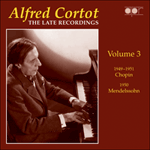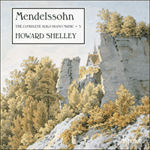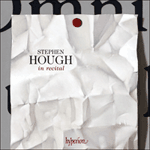
Welcome to Hyperion Records, a British classical label devoted to presenting high-quality recordings of music of all styles and from all periods from the twelfth century to the twenty-first.
Hyperion offers both CDs, and downloads in a number of formats. The site is also available in several languages.
Please use the dropdown buttons to set your preferred options, or use the checkbox to accept the defaults.


Mendelssohn scarcely needed to describe his Variations in D minor as ‘serious’. Contributing to a piano album in aid of the Beethoven monument in Bonn, he no doubt wanted to dissociate his music from the frothy virtuoso stuff that could be expected from some of the other composer–pianists—Czerny, Döhler, Henselt, Kalkbrenner, Moscheles, Taubert and Thalberg—who, along with Chopin and Liszt, had been invited to write pieces for the same album. It is quite clear from Mendelssohn’s earnest theme, presented in severe four-part harmonies, that nothing frivolous is about to happen.
Far from being an inconsequential series of entertaining ideas, the seventeen variations are carefully structured in groups. The first half of the work is built on a gradual increase in tempo and rhythmic activity from the Andante sostenuto of both the theme itself and variation No 1, by way of a strict canon in staccato semiquavers in No 4 and the agitated syncopations of No 5, to the Allegro vivace of Nos 8 and 9. The scurrying triplet semiquavers of No 9 run up against the measured (Moderato) fugato of No 10, which is followed by the cantabile, melancholy No 11 and the violently percussive No 12. The one concession to a virtuoso fashion of the day is the application of Thalberg’s ‘three-hand’ technique to sustain the melodic line as a middle voice in No 13.
The way the score is set out suggests that up to this point the variations should follow each other with either the shortest of breaks or no break at all. Before No 14, however, Mendelssohn inserts a pause, presumably to highlight the consolatory aspect of the one variation in the major, an enchanting Adagio chorale. From there the tempo increases again through the syncopated chords of No 15 to the dazzling Allegro vivace of Nos 16 and 17, which last then slows down for a brief recall of the original theme over left-hand tremolandos. The haste of the Presto coda is intensified by the impression that one hand is chasing the other until they synchronize in the closing bars.
from notes by Gerald Larner © 2009
Mendelssohn n’avait guère besoin de qualifier ses Variations en ré mineur de «sérieuses». Écrivant dans le cadre d’un album pianistique destiné à contribuer à l’érection du monument Beethoven, à Bonn, il voulut probablement se démarquer des trucs virtuoses et creux qu’on pouvait attendre de certains autres compositeurs-pianistes—les Czerny, Döhler, Henselt, Kalkbrenner, Moscheles, Taubert et Thalberg, qui avaient été invités à rédiger des pièces aux côtés de Chopin et de Liszt. Mais le thème fervent de Mendelssohn, présenté en d’austères harmonies à quatre parties, nous assure que rien de frivole ne va se produire.
Loin d’être une insignifiante série d’idées divertissantes, ces dix-sept variations sont soigneusement structurées par groupes. La première moitié de l’œuvre repose sur un accroissement progressif du tempo et de l’activité rythmique à partir de l’Andante sostenuto du thème même et de la Variation no 1 jusqu’à l’Allegro vivace des nos 8 et 9, via un canon strict en doubles croches staccato dans la no 4 et les syncopes agitées de la no 5. Les triolets de doubles croches précipitées de la no 9 se heurtent au fugato mesuré (Moderato) de la no 10, à laquelle succèdent la mélancolique no 11 cantabile et la no 12, violemment percutante. L’unique concession à la mode virtuose de l’époque survient dans la no 13, où est appliquée la technique à «trois mains» de Thalberg destinée à soutenir la ligne mélodique, sous forme de partie intérieure.
À en croire l’agencement de la partition, les variations devraient, jusqu’à ce moment, se suivre avec une pause infime, voire pas de pause du tout. Avant la no 14, cependant, Mendelssohn en insère une, probablement pour souligner l’aspect consolant d’une variation en majeur, un enchanteur chorale Adagio. Dès lors, le tempo s’accroît de nouveau via les accords syncopés de la no 15 pour atteindre l’éblouissant Allegro vivace des deux variations suivantes, celui de la no 17 ralentissant pour un bref rappel du thème original par-dessus des tremolandos à la main gauche. La précipitation de la coda Presto est intensifiée par l’impression qu’une main pourchasse l’autre avant une synchronisation dans les mesures conclusives.
extrait des notes rédigées par Gerald Larner © 2009
Français: Hypérion
Mendelssohn hätte seine Variationen in d-Moll eigentlich nicht „ernst“ nennen müssen. Sie waren ein Beitrag zu einem Klavieralbum, dessen Erlös dem Beethoven-Denkmal in Bonn zugute kommen sollte und er wollte wahrscheinlich seine Musik von den seichten, virtuosen Werken absetzen, die von einigen der anderen Komponisten bzw. Pianisten zu erwarten waren—unter ihnen Czerny, Döhler, Henselt, Kalkbrenner, Moscheles, Taubert und Thalberg—die, ebenso wie Chopin und Liszt, ebenfalls eingeladen worden waren, Stücke für das Album zu komponieren. Doch kann man dem ernsten Thema, das Mendelssohn wählte und in einem strengen, vierstimmigen Satz präsentierte, sofort entnehmen, dass es sich hier nicht um leichte Musik handelt.
Dieser Zyklus ist keineswegs eine belanglose Aneinanderreihung unterhaltsamer musikalischer Ideen, sondern es handelt sich hier um 17 Variationen, die sorgfältig in mehrere Gruppen gegliedert sind. In der ersten Hälfte des Werks steigern sich Tempo und Rhythmik des Andante sostenuto im Thema selbst und auch in Variation Nr. 1, indem in Nr. 4 ein strenger Kanon in Staccato-Sechzehnteln und bewegte Synkopierungen in Nr. 5 zum Allegro vivace in Nr. 8 und 9 hinführen. Die eilenden Sechzehntel-Triolen in Nr. 9 treffen dann auf das gemessene Fugato (Moderato) in Nr. 10, auf das das melancholische Cantabile von Nr. 11 und die wilde, perkussive Nr. 12 folgen. Das einzige Zugeständnis, das Mendelssohn an die modische Virtuosität macht, ist Thalbergs „dreihändige“ Technik, die er einsetzt, um die Melodie-Linie in Nr. 13 als Mittelstimme herauszuarbeiten.
Die Anlage des Notentexts lässt vermuten, dass bis zu diesem Punkt die Variationen mit nur sehr kurzen oder überhaupt keinen Pausen aufeinander folgen sollen. Vor Nr. 14 fügt Mendelssohn jedoch eine Pause ein, wahrscheinlich um das tröstende Element dieser Variation, die als einzige in Dur steht und als zauberhafter Adagio-Choral angelegt ist, hervorzuheben. Von da an zieht das Tempo durch die synkopierten Akkorde in Nr. 15 zu dem brillanten Allegro vivace von Nr. 16 und 17 hin an und ebbt danach wieder ab, wenn das ursprüngliche Thema über Tremolandi in der linken Hand noch einmal kurz wiederkehrt. Die Eile der Coda (mit Presto überschrieben) wird durch den Eindruck intensiviert, dass eine Hand die andere jage, bevor sie in den letzten Takten synchron erklingen.
aus dem Begleittext von Gerald Larner © 2009
Deutsch: Viola Scheffel
 Alfred Cortot – The Late Recordings, Vol. 3 - Chopin & Mendelssohn Alfred Cortot – The Late Recordings, Vol. 3 - Chopin & Mendelssohn |
 Mendelssohn: The Complete Solo Piano Music, Vol. 5 Mendelssohn: The Complete Solo Piano Music, Vol. 5More powerful advocacy from Howard Shelley for Mendelssohn’s unjustly neglected piano music.» More |
 Stephen Hough in recital Stephen Hough in recitalThe Hough discography is enhanced by this delightful recital disc from the winner of the Gramophone Gold Disc Award, acclaimed recently as ‘Britain’s finest pianist’ (The Sunday Times), and as one of the six greatest pianists performing in the wor ...» More |

